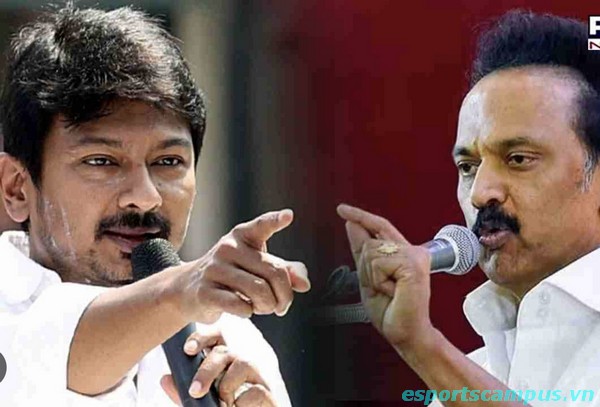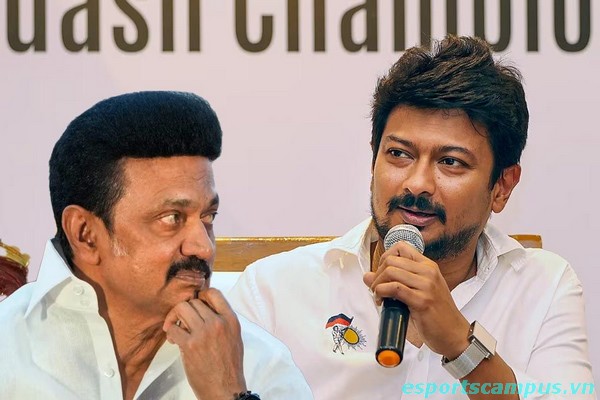DMK Sanatana Dharma Congress wants to repeal this law
The recent controversy surrounding the DMK (Dravida Munnetra Kazhagam) and its stance on Sanatana Dharma, also known as Hinduism, has ignited a significant political firestorm in Tamil Nadu. In a region where religion and culture are deeply intertwined, any discussion on matters of faith and identity tends to carry profound implications. The DMK Sanatana Dharma position has become a focal point of debate, stirring emotions and raising questions about the delicate balance between preserving cultural heritage and safeguarding religious freedom. This contentious issue has captured the attention of the public, political analysts, and scholars alike, shedding light on the complex interplay between politics, culture, and religion in this vibrant and historically rich part of India. Read more at esportscampus.vn!

I. Introduction about the DMK Sanatana Dharma
DMK (Dravida Munnetra Kazhagam) is a prominent political party in India, primarily based in the state of Tamil Nadu. Founded in 1949, DMK has become a significant player in the political landscape of the region and has, at various times, held power in the state government.
The core philosophy and ideology of DMK have been deeply influenced by the Self-Respect Movement, an important social and political reform movement initiated by E.V. Ramaswamy ‘Periyar’ in the early 20th century. This movement had its roots in Tamil Nadu and was dedicated to advocating for social justice, equality, and the eradication of caste-based discrimination and religious orthodoxy. Periyar and the Self-Respect Movement vehemently opposed the prevailing social hierarchies and religious dogmas that were pervasive in society at the time.
The Self-Respect Movement sought to empower marginalized communities, particularly the lower castes, and promote rationalism and critical thinking. It challenged the entrenched social norms that perpetuated caste discrimination and inequality, advocating for a more equitable and inclusive society.
DMK, as a political offshoot of this movement, adopted many of its principles and ideals. It embraced the cause of social justice and worked towards dismantling the deeply rooted caste-based discrimination that had plagued Tamil Nadu and other parts of India for centuries. Additionally, DMK took a stand against religious orthodoxy and the dominance of certain religious practices, aligning itself with the broader goals of secularism and rationalism.

II. Controversy over Sanatana Dharma
Udhayanidhi Stalin, a prominent leader within the DMK, has been at the center of a heated controversy surrounding the party’s stance on Sanatana Dharma. He made a striking declaration that Sanatana Dharma is fundamentally opposed to the principles of social justice and, as such, should be eliminated or eradicated. This statement by a key figure in the DMK leadership sent shockwaves through the political landscape of Tamil Nadu and sparked intense debates both within the state and at the national level.
Udhayanidhi Stalin’s assertion points to a deep-seated ideological divide. He appears to view Sanatana Dharma, often referred to as Hinduism, as an obstacle to the realization of social justice and equity. It suggests that, in his perspective, certain aspects of the religious and cultural traditions embedded within Sanatana Dharma perpetuate inequalities and hinder progress towards a more inclusive society.
In response to Udhayanidhi Stalin’s statement and DMK’s position on Sanatana Dharma, the Bharatiya Janata Party (BJP) and other political opponents alleged that this stance is not just an isolated viewpoint but rather part of a larger political agenda orchestrated by the Indian opposition alliance.
The BJP’s allegations add a layer of complexity to the controversy. They suggest that the DMK’s criticism of Sanatana Dharma goes beyond ideological differences and is potentially tied to broader political strategies. The BJP, a political party with a strong presence in national politics, has accused the opposition alliance, of which DMK is a significant part, of pursuing an agenda that may include challenging the cultural and religious traditions associated with Sanatana Dharma.
III. The Significance of Sanatana Dharma
1. The meaning of Sanatana Dharma is eternal and unchanging
Sanatana Dharma, often referred to simply as Hinduism, holds profound significance in Indian culture and spirituality. The term “Sanatana” translates to “eternal” or “everlasting,” and “Dharma” refers to the moral and ethical principles that guide one’s life. Therefore, Sanatana Dharma is often understood as the eternal moral and ethical framework that underpins the Hindu way of life.
Eternal Principles: Sanatana Dharma is characterized by its belief in the timeless nature of its principles. It asserts that these principles are not subject to change or alteration over time. This perspective contrasts with many other belief systems that may evolve or adapt their teachings in response to changing circumstances. Sanatana Dharma, in its essence, emphasizes the eternal nature of truth, morality, and spiritual wisdom.
2. Udhayanidhi Stalin mentioned that Sanatana divides people based on caste
Udhayanidhi Stalin, a prominent leader within the DMK, has expressed a viewpoint that stands in stark contrast to the traditional understanding of Sanatana Dharma! He has stated that Sanatana Dharma has the divisive effect of categorizing people based on their caste identities.
Caste Divisions: Udhayanidhi Stalin’s assertion points to a specific concern regarding the caste system within Hinduism. Historically, India’s caste system has been a complex and deeply ingrained social hierarchy that categorizes individuals into distinct groups, often determining their social status, occupations, and even their access to basic rights and privileges.
Social Justice Concerns: From Udhayanidhi Stalin’s perspective, Sanatana Dharma’s association with caste divisions may be seen as a hindrance to the pursuit of social justice and equality. It suggests that certain elements of Hindu traditions and practices may reinforce or perpetuate these divisions, making it difficult to achieve a more just and inclusive society.

IV. History of DMK and the Self-Respect Movement
1. DMK has its origins in the Self-Respect Movement initiated by Periyar
The DMK (Dravida Munnetra Kazhagam) has its origins deeply rooted in the Self-Respect Movement, a profound social and political reform movement instigated by E.V. Ramaswamy, famously known as ‘Periyar,’ during the early 20th century. This movement was primarily driven by the noble goal of combatting the pervasive issues of caste-based discrimination and religious orthodoxy, while tirelessly advocating for the principles of social justice and equality. DMK, in essence, emerged as a political manifestation and extension of the principles espoused by the Self-Respect Movement.
Periyar, an instrumental figure in the Self-Respect Movement, was an unwavering champion of social reform. His unwavering resolve led him to challenge the oppressive caste system and the subjugation of women, all the while passionately advocating for their rights and empowerment. Additionally, Periyar vigorously opposed the dominance of the Hindi language, fervently stressing the preservation of Tamil culture and identity.
In 1938, a pivotal moment took shape when the Justice Party, a political entity in Tamil Nadu, joined forces with the Self-Respect Movement, laying the cornerstone for the establishment of Dravidar Kazhagam (DK) in 1944. This collaboration represented a monumental juncture in the history of the Self-Respect Movement, as it amalgamated both political and social activism with the overarching aim of addressing the deeply ingrained societal issues of the time.
2. Annadurai’s DMK aimed for social democracy and Tamil cultural nationalism
Following India’s independence in 1947, C.N. Annadurai, a close associate of Periyar, emerged as a pivotal figure in shaping the trajectory of the Dravida Munnetra Kazhagam (DMK). Under Annadurai’s leadership, DMK underwent a transformational shift, embracing the tenets of social democracy and Tamil cultural nationalism as its foundational principles. This marked a departure from its earlier emphasis on the self-respect movement. The party’s renewed focus was on uplifting marginalized communities and championing the cultural heritage of Tamil Nadu. Annadurai’s astute leadership not only propelled DMK to electoral triumphs but also established it as a significant political force in the region.
Yet, the annals of DMK’s history are marked by a significant rupture. In 1972, ideological disparities and leadership differences led M.G. Ramachandran (MGR) to splinter from DMK and establish the All India Anna Dravida Munnetra Kazhagam (AIADMK). During his tenure as Chief Minister of Tamil Nadu, MGR steered AIADMK in a different direction. This shift involved departing from some core principles of the self-respect movement, such as opposition to caste discrimination and religious orthodoxy, in favor of a more welfare-driven approach.
The narrative of DMK’s evolution, as well as its intertwined relationship with the Self-Respect Movement, intricately illustrates the multifaceted interplay between social reform, politics, and cultural identity in the Tamil Nadu context. This historical trajectory underscores how political ideologies can undergo transformations and divergences over time, ultimately shaping the trajectories of political parties within the region. The DMK’s journey stands as a testament to the intricate dance between ideology, leadership, and socio-political change in the complex tapestry of Tamil Nadu’s socio-political landscape.
V. Conclusion about the DMK Sanatana Dharma
The DMK rich history finds its roots in the Self-Respect Movement, a transformative social and political reform movement initiated by E.V. Ramaswamy ‘Periyar’ in the early 20th century. This movement was a response to the deeply ingrained issues of caste-based discrimination and religious orthodoxy that prevailed in Tamil Nadu and other parts of India. The DMK’s adoption of many principles from the Self-Respect Movement is a testament to its enduring commitment to social justice, equality, and the welfare of marginalized communities. This historical connection continues to shape the party’s ideology, policies, and political agenda.
In recent times, the political landscape of Tamil Nadu has been marked by a significant controversy surrounding Sanatana Dharma, which is causing notable political tension in the state. Sanatana Dharma, often referred to as Hinduism, is deeply ingrained in the cultural and religious fabric of Tamil Nadu. However, the controversy stems from differing interpretations and perspectives on the practice and representation of this ancient belief system.
This issue has led to heated debates and discussions, often pitting different political and social groups against each other. The tensions have primarily revolved around questions of cultural appropriation, religious freedom, and the safeguarding of Tamil identity. Some argue that certain practices associated with Sanatana Dharma have encroached upon Tamil cultural traditions, while others emphasize the importance of preserving religious diversity and individual rights.
The controversy over Sanatana Dharma in Tamil Nadu is a reflection of the broader complexities that exist at the intersection of religion, culture, and politics. It underscores the challenges faced by political leaders and policymakers in addressing sensitive issues that have deep historical and cultural roots.